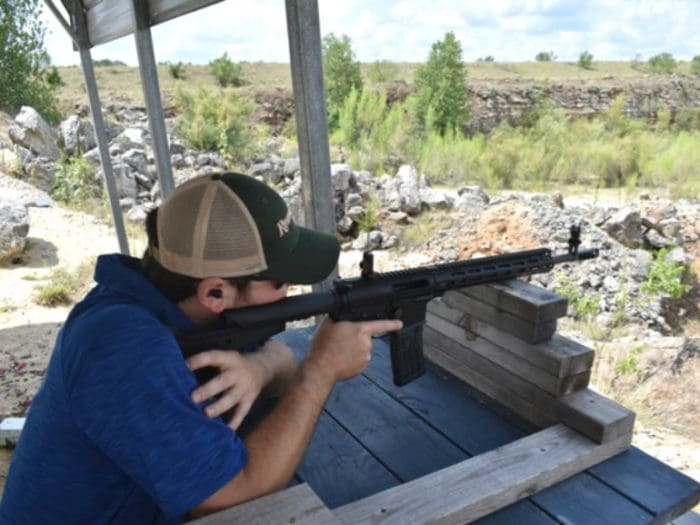This is not a review. That’s coming after further use and reliability testing. But Chris and I were so impressed with Ultradyne‘s new flip-up iron sights that I wanted to show them to y’all right away . . .
Spoiler alert: the front post is an aperture sight. That’s right, Ultradyne’s C4 Folding Sights are a dual-aperture setup. It isn’t the first — this is how biathlon sights are generally designed — but it may be the first for the AR-15 market.
Different front aperture diameters are available. Standard in the C4s is a 12 MOA aperture, which is seen above second from the right.
The rear aperture is also exchangeable for other sizes. It’s very simple to unscrew the aperture insert from the sight.
Leaving the rear aperture out completely turns the rear sight into a ghost ring for extremely quick acquisition.
On the left side of the rear sight is an elevation dial that’s click-adjustable for distance. Chris and I found it to be spot-on out to the 440-yard back wall of the range we used for testing (where we abused steel plates from 200 to 440 like you wouldn’t believe), and will test it even farther for the full review.
That dial is aligned for the ballistics of M193 ammo, but the end user can calculate a drop table for other loads as well (e.g. “4” on the dial might be a 375-yard hold for 75 grain ammo instead of its normal 400-yard hold for 55 grain).
Don’t worry about losing that rear aperture, either. Simply screw it into the elevation adjustment dial for storage.
Ultradyne’s C4 front sight is also adjustable for elevation, as you’d expect, but it’s adjustable for windage, too. I can’t recall seeing that before. While not strictly necessary, it provides one really cool benefit: the rear sight stays centered in its housing.
Ultradyne recommends you sight in your gun via front sight adjustment, not rear. That way you’re sighted in with the rear sight centered so you can actually adjust the rear for windage while shooting, then easily return back to its center zero.
That’s not even the coolest adjustment feature of the front sight, either. Instead of requiring a tool to release the detent and rotate the front post, the user simply clicks the front sight hood down, then rotates the post by hand. Since the aperture is drilled through, front-to-back as well as side-to-side, front can become side and you still have an aperture to look through (you have the normal 90° rotation steps).
Better yet, the front post always remains centered in the hood. This is huge for your eyes and brain, which just love centering circles in circles.
In fact, this is why the whole setup is so freaking fast and accurate. Centering that round front aperture in the round rear aperture with the help of the round front hood aligning inside the rear is incredibly precise — which I think is easy to imagine — but also orders of magnitude faster than Chris or I expected.
It’s beyond easy; it’s instinctual. Trying to center a square front post in a round rear peep sucks. It actually makes no visual sense (in fact, I’ve historically run KNS ball front posts on my rifles). The Ultradyne system clicks instantly. It’s easy and oh-so-fast to teach, learn, and use.
An aperture front post also allows you to see the target. Don’t focus on the front sight, and don’t deal with the front post obscuring your target, either. Center the target in the front aperture, focus on the target, and squeeze the trigger. Viewing through apertures actually provides a certain amount of vision and parallax correction, too.
But wait! There’s more! While Ultradyne’s standard C4 Folding Front Sight mounts on your top rail, their C4 Dynamount front sight mounts on the barrel itself. A pin on the sight indexes into one of three holes on one of Ultradyne’s muzzle devices (centered, or 45° offset to either side), and a lock nut clamps it all together, making timing easy.
I know, it may seem like a gimmick. That’s where my head was when I initially saw this setup. But when you take even the highest quality, free-floating rails, put just a pound or two of pressure on them, and watch your rail-mounted front sight walk off target, you understand the choice.
We’ll have some of this rail flex-induced point of aim shift data in the full review (10 MOA of shift is shockingly easy to induce).
With the rear sight mounted solidly on the receiver and the front sight on the barrel, that concern disappears. Sight radius, too, is stretched to as long as possible for the most precise alignment for your rifle. It may look a little goofy — or at least non-traditional — but dangit, it works. And timing that front sight was far easier than expected.
The Dynamount front sight still folds, and will sit right down on top of a full-length upper rail should your handguard extend that far.
Machining and finish on these Ultradyne parts is as good as we’ve seen in any product. The wide, notch-style detent used to snap the sight into deployed position is as snug and solid as can be.
Basically, these are probably the best iron sights on the market. And I won’t even call them “backup irons,” because they’re so freaking fast and so accurate that they’re better than many optics. These sights are going to find themselves on my first dedicated iron-sights-only AR-15 build.
Stay tuned; full review pending.
